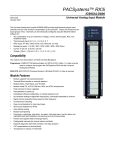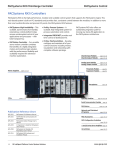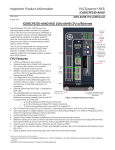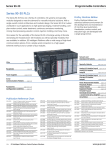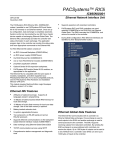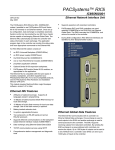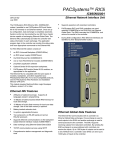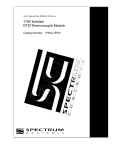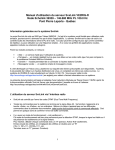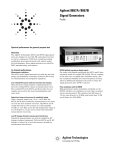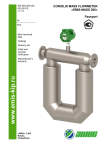Download RX3i Universal Analog Input Module, IC695ALG600-DD, GFK
Transcript
PACSystems* RX3i IC695ALG600-DD GFK-2348J May 2014 Universal Analog Input Module The PACSystems Universal Analog Input module IC695ALG600 provides eight general purpose input channels and two Cold Junction Compensation (CJC) channels. Inputs are divided into two equal groups of four. Channels can be individually-configured using the Proficy* Machine Edition software for: ▪ Any combination of up to eight channels of voltage, current, thermocouple, RTD, and resistance inputs. ▪ Thermocouple Inputs: B, C, E, J, K, N, R, S, T ▪ RTD Inputs: PT 385 / 3916, N 618 / 672, NiFe 518, CU 426 ▪ Resistance Inputs: 0 to 250 / 500 / 1000 / 2000 / 3000 / 4000 Ohms ▪ Current: 0–20 mA, 4–20 mA, +20 mA ▪ Voltage: +50mV, +150 mV, 0–5 V, 1–5 V, 0–10 V, +10V This module must be located in an RX3i Universal Backplane. An RX3i CPU with firmware version 2.80 (Build ID 43A1) or later. Proficy Machine Edition 5.0 SP1A LD-PLC Hotfix 1 ) or later is required for configuration. This module can be used with a Box-style (IC694TBB032), Extended Box-style (IC694TBB132), Spring-style (IC694TBS032), or Extended Spring-style (IC694TBS132)) Terminal Block. Extended terminal blocks provide the extra shroud depth needed for shielded wiring. See the PACSystems RX3i System Manual, GFK-2314 revision B or later for more information about Terminal Blocks. Terminal Blocks are ordered separately. Module Features ▪ Module supports hot insertion/extraction ▪ Terminal Block insertion or removal detection ▪ Module Status, Field Status, and TB LEDs ▪ Module meets CE, UL/CUL 508 and 1604, and ATEX requirements ▪ Flash memory for future upgrades ▪ Autocalibration at power-up ▪ Completely software-configurable, no module jumpers to set ▪ Six hardware analog-to-digital filter frequencies, individually-selectable by channel ▪ Rapid channel acquisition times based on filter frequency ▪ On-board error-checking ▪ Open-circuit detection for most input types ▪ Short-circuit detection for RTDs. ▪ User-defined scaling ▪ Module fault reporting ▪ Overrange, underrange, high alarm, low alarm, high-high alarm, low-low alarm and calibration fault alarm detection and reporting on a per-channel basis. ▪ Positive and negative Rate of Change Alarms ▪ Configurable interrupts for channel alarms and faults ▪ Supports diagnostic point fault contacts in the logic program. ▪ CJC compensation on terminal block ▪ Temperature in Celsius or Fahrenheit ____________________________ © 2014 General Electric Company. All Rights Reserved. *Indicates a trademark of General Electric Company and/or its subsidiaries. All other trademarks are the property of their respective owners. RX3i Universal Analog Input Module 2 GFK-2348J Release Information Release History Release Hardware Update Firmware Revision IC695ALG600-DD This version of the product contains an enhancement to the design that improves the tolerance of terminal block detection. Primary: 1.14 Boot: 1.10 IC695ALG600-DC Label change only. No change in functionality, performance or compatibility. Primary: 1.11 Boot: 1.10 IC695ALG600-CC Modified the terminal block detector switch to increase the size of the switch lever. The increased size of the switch lever allows additional tolerance to assure contact with the terminal block actuator. Primary: 1.11 Boot: 1.10 IC695ALG600-BC Improved noise immunity Primary: 1.11 Boot: 1.10 IC695ALG600-AB None Primary: 1.10 Boot: 1.10 Initial Release None Primary: 1.00 Boot: 1.00 Firmware Upgrade Revision –xA, –xB and –xC modules can be upgraded to firmware version 1.14 using upgrade kit 44A753049-G03, which is available for downloading at http://www.ge-ip.com/support.. Functional Compatibility Subject Description Programmer Version Requirements Machine Edition Logic Developer 5.0 + Service Pack 1A with LD-PLC Hotfix 1 or later must be used to configure and program the Universal Analog Input Module. CPU Firmware Version Requirements PACSystems RX3i CPU version 2.80 or later must be used to configure and operate the Universal Analog Input Module. Problems Resolved in Firmware Version 1.14 Subject Description Accuracy of CJC on IC695ALG600 does not meet specification. In Firmware versions 1.11 and earlier of the the IC695ALG600, channels configured for RTD inputs that have no input connected (open wire condition) affect the next sampled input channel. The CJC sensor is the most sensitive to this issue, and will read about 6 °F high. Thermocouple inputs are also affected by this issue. For example, if channels 5 and 6 are configured for T/C while 7 and 8 are RTD with an open wire condition, channels 5 and 6 will read about 6 °F high. When changing 7 and 8 to T/C, the channels 5 and 6 start reading the correct cold junction compensation value. This has been corrected in version 1.14 IC695ALG600 – Thermocouple reading oscillates between high and low values with open circuit. With Firmware versions 1.11 and earlier, when a thermocouple connection is left open (that is, a channel is configured for T/C but nothing is connected to the terminals for that channel), the values read for that T/C circuit will oscillate between high and low values. This has been corrected with Firmware version 1.14. With Firmware version 1.14, if the T/C channel is left open (i.e. a channel is configured for T/C but nothing is connected to the terminals for that channel), the open circuit data value will be held at the Low Scale Value (Engineering Units). RX3i Universal Analog Input Module Subject IC695ALG600 – Open wire detection does not work consistently 3 GFK-2348J Description With firmware versions 1.11 and earlier: When channels are configured such that T/C channels are adjacent to CJC channels in scan order, Open Wire detection does not work consistently (That is, the designated reference bit does not get set, or in some occurrences, the reference bit for the next T/C channel is set instead.) Scan order is channel 1, 2, 3, 4, CJC1, then channel 5, 6, 7, 8, CJC2 Firmware version 1.14 corrects this issue and will detect an open wire condition when T/C channels are configured adjacent (scan order) to a CJC. New Features and Enhancements in Release 1.14 This version of the Universal Analog Input module firmware provides improved tolerance of terminal block detection. Known Restrictions and Open Issues in this Release Subject Description Temperature Offset Drift The module exhibits offset drift with temperature. On some channels, this is enough to cause the readings to go outside the allowed over-temperature accuracy specification. Recommendation: Run an autocalibration on the module. Incorrect Display of Deadband limits When changing configurations from one input type to another in Proficy Machine Edition, the deadband limits and/or the positive rate of change limits for the module may be incorrect. More specifically, the values for these limits may increase or become invalid each time the configuration is switched from one input type to another. For example, if Fahrenheit is selected for a thermocouple input type and the input type is then changed to voltage, the deadband limits do not change to reflect appropriate values for the voltage input type and remain in units of Fahrenheit. Switching back to a thermocouple input type could then result in all values defaulting to Celcius, but the deadband limits remaining in units of Fahrenheit. Operating Notes Unused RTD Channels Must Have a Jumper Channels that have been configured as an RTD channel, but are not connected must have a jumper installed to assure proper operation. Failure to do so could affect the accuracy of adjacent channels. For additional information, including a wiring diagram, refer to the section, Module Wiring. Diagnostic Reporting for Interrupts The Universal Analog Input module has separate enable/disable options for Diagnostic Reporting and Interrupts. Normally, disabling a diagnostic (such as Low/High Alarm or Over/Under range) in the configuration means that its diagnostic bit is never set. However, if interrupts are enabled for a condition and that interrupt occurs, the diagnostic bit for that condition is also set during the same PLC scan. The next PLC input scan always clears this interrupt status bit back to 0, because Diagnostic Reporting has it disabled. RX3i Universal Analog Input Module 4 GFK-2348J Specifications Backplane Power Requirements 300 mA maximum @ 5.0V 320 mA maximum @ 3.3V Power Dissipation within Module Thermal Dissipation 5.4 watts maximum LEDs One green LED to indicate the module status One bi-color green/yellow LED to indicate the field status One bi-color red/green LED to indicate the terminal block status Per Channel Acquisition Time (Each 10 msec @ 1000 Hz, 13 msec @ 200 Hz, 27 msec @ 40 Hz, 67 msec @ 16 Hz, 87 group scanned independently) msec @ 12 Hz, 127 msec @ 8 Hz Channel Update Time The sum of the channel acquisition times for a bank of 4 channels plus one of the following if applicable: 1. RTD Lead resistance measurement time (equals channel acquisition time) 2. CJC acquisition time 7 msec. Input resolution 11 to 16 bits, depending on configured range and A/D filter frequency. Resistance 0-250, 0-500, 0-1000, 0-2000, 0-3000, 0-4000 Inputs in Ohms RTD Inputs Thermocouple Inputs Platinum 385 100, 200, 500,1000 Platinum 3916 100, 200, 500,1000 Nickel 672 120 Nickel 618 100,200, 500,1000 Nickel-Iron 518 604 Copper 426 10 Copper 426 -100 to 260°C Nickel 618 -100 to 260°C Nickel 672 -80 to 260°C Nickel-Iron 518 -100 to 200°C Platinum 385 -200 to 850°C Platinum 3916 -200 to 630°C Type B 300 to 1820°C Type C 0 to 2315°C Type E -270 to 1000°C Type J -210 to 1200°C Type K -270 to 1372°C Type N -210 to 1300°C Type R 0 to 1768°C Type S 0 to 1768°C Type T -270 to 400°C Voltage Inputs -10V to +10V, 0V to +10V, 0V to +5V, 1V to +5V, -50mV to +50mV, -150mV to +150mV Current Inputs -20mA to +20mA, 4 to 20mA, 0 to 20mA Configurable Input Filter 8 Hz, 12 Hz, 16 Hz, 40 Hz, 200 Hz, 1000 Hz Scaling Floating point user scaling. Max RTD Cable Impedance 25 ohm RTD Wire Length 1000 ft max w/settling time of 1mSec Input Impedance >1M ohm for TC/V/RTD Current Input Resistance 249 ohm +/- 1% RX3i Universal Analog Input Module 5 GFK-2348J Open circuit detection time 5 seconds max. Open circuit detection is available for all configurations except +/20mA current, 0-20mA current, and +/-10V voltage. Max Overvoltage +/-14.5VDC continuous Max Overcurrent 28 mA continuous Normal Mode Noise Rejection 95 dB minimum @ 50/60 Hz with 8 Hz filter 85 dB minimum @ 50/60 Hz with 12 Hz filter Common Mode Noise Rejection 120dB minimum @ 50/60 Hz with 8 Hz filter 110dB minimum @ 50/60 Hz with 12 Hz filter Settling time to 5% of Full Scale (notch filter dependent) <80 mS Calibrated Accuracy at 25°C Better than 0.1% of range (except 10 ohm CU RTD) Accuracy depends on A/D filter, data format, input noise, and ambient temperature. Calibration interval 12 months typical to meet accuracy specifications over time. Module will allow for user offset to be applied as a periodic calibration adjustment. Input Offset Drift with Temperature 3.0 milliohm/°C maximum 2.0 uV/°C maximum Gain Drift with Temperature 50 ppm/°C typical (90 ppm/°C maximum) Module error over Full Temp range 0.5% of range typical (depends on range) 1.0% of range maximum Module Scan Time (notch filter dependent) (Assumes 2 ADC’s running in parallel, no CJC or lead resistance) 10 ms per Channel × 4 Channels = 40 ms (1K Hz filter) 127 ms per Channel × 4 Channels = 508 ms (8 Hz filter) Channels that are disabled are not scanned, shortening scan time. Module conversion method Sigma-delta Isolation Voltage channel to channel group to group terminal block to backplane/chassis Opto-isolated, transformer isolated +-12.5Vdc channel to channel Tc/V/I/RTD 250 VAC continuous/1500 VAC for 60 seconds 250 VAC continuous/1500 VAC for 60 seconds LEDs The Module OK LED indicates module status. The Field Status LED indicates the presence of a fault on at least one channel or a terminal block error. The TB (Terminal Block) LED indicates the presence or absence of the terminal block. LEDs are powered from the backplane power bus. LED Module OK Field Status TB Indicates ON Green: Module OK and configured. Slow Flashing Green or Amber: Module OK but not configured. Quick Flashing Green: Error. OFF: Module is defective or no backplane power present ON Green: No faults on any enabled channel, and Terminal Block is present. ON Yellow: Fault on at least one channel. OFF: Terminal block not present or not fully seated. ON Red: Terminal block not present or not fully seated. ON Green: Terminal block is present. OFF: No backplane power to module. RX3i Universal Analog Input Module 6 GFK-2348J Module Wiring The table below lists wiring connections for the module. Except for RTD and resistance type inputs, channels are wired as differential inputs. There are no shield terminals. TC / Voltage / Current RTD or Resistance 1 CJC1 IN+ Channel 1 EXC+ 2 CJC1 IN- Channel 1 IN+ Channel 2 IN+ Channel 1 IN- Channel 2 iRTN Channel 3 EXC+ Channel 2 IN - Channel 3 IN+ Terminal RTD or Resistance 3 Channel 2 EXC+ 4 Channel 2 IN+ 5 6 Channel 2 IN- 7 Channel 4 EXC+ 8 Channel 4 IN+ 9 10 Channel 4 IN- 11 Channel 6 EXC+ 12 Channel 6 IN+ 13 14 Channel 6 IN- 15 Channel 8 EXC+ 16 Channel 8 IN+ 17 18 Channel 8 IN- Channel 4 IN+ Channel 3 IN- Channel 4 iRTN Channel 5 EXC+ Channel 4 IN - Channel 5 IN+ Channel 6 IN+ Channel 5 IN- Channel 6 iRTN Channel 7 EXC+ Channel 6 IN- Channel 7 IN+ Channel 8 IN+ Channel 7 IN- Channel iRTN Channel iRTN 19 Channel 1 IN+ 20 Channel 1 iRTN 21 Channel 1 IN - 22 23 Channel 3 IN+ 24 Channel 3 iRTN 25 Channel 3 IN- 26 27 Channel 5 IN+ 28 Channel 5 iRTN 29 Channel 5 IN- 30 31 32 Channel 7 iRTN 33 Channel 7 IN- 34 Channel 8 iRTN CJC2 IN+ 35 Channel 8 IN- CJC2 IN- 36 RTD / Resistance Current Input 2 Wire RTD or Resistor I Channel EXC+ Channel IN+ Channel INChannel IN+ Terminal Channel 7 IN+ Thermocouple / Voltage / Current Channel IN+ TC / Voltage / Current Channel IN- Voltage Input V 3 or 4 Wire RTD or Resistor Channel IN- For current inputs, tie the Return to the associated INpin. Channel EXC+ Excitation Channel IN+ Sense + Channel IN- RTD Return Sense Negative sense not connected on 4-Wire RTD ▪ ▪ ▪ ▪ For 2 wire RTDs, tie EXC+ and IN+ together at the terminal block. For 4 wire RTDs, leave one of the negative sense leads off. For 3 wire RTDs, IN+ = Sense+, IN- = RTD Return, and EXC+ = Excitation current. Unconnected RTD channels must have a jumper installed to assure proper operation. Failure to do so could affect the accuracy of adjacent channels. RX3i Universal Analog Input Module 7 GFK-2348J Installing CJC Sensors When using any thermocouple inputs on this module, the use of CJC sensors is recommended. Installing one CJC sensor will greatly improve the accuracy of thermocouple readings. Installing two CJC sensors will provide the highest thermocouple input accuracy for the module. Refer to GFK-2314, PACSystems RC3i System Manual, the section, CJC Scan Enable (Revision A or later) for information about configuring and using CJC sensors. A CJC sensor compensates for offset voltages introduced into the input signal where the thermocouple wires are connected to the module. A set of two CJC sensors is available as part number IC695ACC600. CJC1 IN+ CJC1 IN- Thermistor End CJC Sensor Using both CJCs provides highest thermocouple compensation accuracy. Using only CJC1 lowers the thermocouple compensation accuracy, but can improve scan time for channels 5-8. Using only CJC2 lowers the thermocouple compensation accuracy, but can improve scan time for channels 1-4. CJC2 IN+ CJC2 IN- Spring-style Terminal Block The thermistor end of the CJC sensor must be installed in the CJC1 IN+ or CJC2 IN+ terminal for accurate temperature measurements. The gold pin end of the CJC sensor must be installed in the CJC1 IN- or the CJC2 IN- terminal. Open the Terminal Block contacts fully before installing the CJC sensor. Insert the sensor into the Terminal Block contact, maintaining metal-to-metal contact between the thermistor and the Terminal Block contact. For a Box-style Terminal Block, maintain pressure while screwing down the contact. Isolated Input Groups This module provides two isolated groups of four input channels each. This allows fast inputs and slower or highly-filtered inputs to be connected to the same module without adversely affecting the update rate of the fast inputs. To take advantage of this feature, up to four inputs requiring fast response should be placed together in one isolated group while slower inputs should be connected to the other isolated group. For example, voltage and current inputs with higher frequency input filter settings should be grouped together on one of the isolated groups while thermocouple, RTD, resistance, or voltage/current inputs with low-frequency input filter settings should be grouped together on the other isolated group. Each isolated group provides a CJC input. The CJC input is considered a slow-response input and will reduce the update rate for the associated channel group when enabled. Connecting Channels to the Same Thermocouple Point When connecting one or more channels from channels 1–4 and one or more channels from channels 5 - 8 to the same thermocouple point electrically, the point should be grounded. It can be grounded at either the sensor or the module, by adding a jumper wire from frame ground to the low side of one thermocouple input. Resolution and Update Time The actual resolution and update time for each input depend on the channel’s configured Range Type and A/D Filter Frequency, as described in GFK-2314, RX3i System User’s Manual. At higher Filter Frequencies, channel update time increases while input resolution decreases. The approximate number of bits for each Filter Frequency and Range Type are shown in the table below. Filter Frequency 8 Hz 12 Hz 16 Hz 40 Hz 200 Hz 1000 Hz Range Type: Voltage / Current Approximate Number of Bits 16 16 16 16 14 11 Range Type: TC / mV Approximate Number of Bits 16 16 16 14 13 11 Channel Update Time 127 ms 87 ms 67 ms 27 ms 13 ms 10 ms







